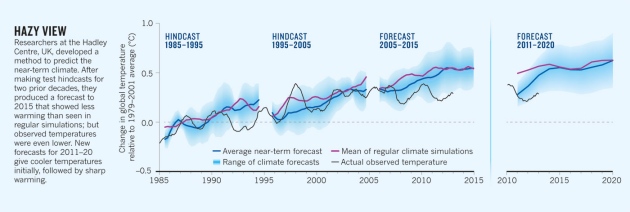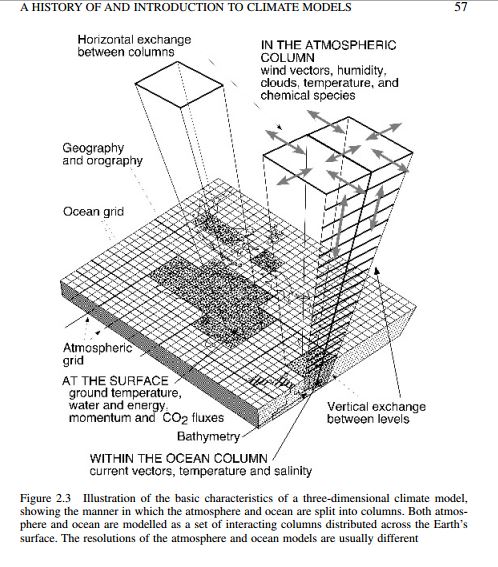From the scientific journal Nature:

Here, for our interested readers, is an image from a book I have at home on Climate Modeling. The general circulation models that I referred to in my earlier post divide the entire atmosphere into 3 dimensional figures (rectangles) like so:

They do the same thing for the ocean. One of the difficulties for modelers is that some basic physical and chemical properties (the first law of thermodynamics, the second law of motion, the conservation of mass and the ideal gas law) must be applied to each of the rectangles they created. For example, the transfer of energy and matter must be calculated between each rectangular volume and its neighbors. That means there are six calculations for each rectangle. Needless to say that is a lot of calculations, which only increase as we try to make models more precise by shrinking the rectangle sizes. There are two problems here. First is that the first calculations of the states of each rectangle DO NOT take into account the calculated states of any others, so the model takes a very, very long time and lots of computing power to converge. As I suggested in my earlier post, this design requires that the GCM climate models have to be equilibrium models, else the system of equations cannot converge to provide an answer. A second, and related, problem is that with rectangle sizes that are too large, the models are not fine-tuned enough to even, in principle, model things like small-scale atmospheric dynamics, such as thundercloud formation – which is obviously extremely important for understanding climate feedback and the effects of an increase of CO2 on the planet. It goes without saying that we are unable to model the vast number of interactions between various climactic processes, such as the interaction between the ocean-surface and the atmosphere, and that even if we get better computational power in the future, the same parameterization is going to be required as mentioned above with the atmospheric rectangles.
And these current “state of the art” GCM are indeed a step above the models used to develop the work in the earlier renditions of the IPCC report (the next is coming in September). Even so, fudge factors are required when the models cannot be fully equilibrated. If you read through the climate modeling literature, you will come quickly to respect the enormity of the task of modeling climate, and you will see easily that no one who writes those books is covering up anything. The point I was, and will continue to, making was that we are not able to model easily the stochastic and dynamic nature of our actual ecosystems. That the entire way we think about “Nature” is perhaps off-kilter. Indeed, the way our 2 children are taught in grade school can’t be right – that God’s world was pristine and in a perfect equilibrium until we went and fouled it up. And not only do I fear that our thinking about nature in this unrealistic way is wrong for metaphysical reasons, but actually enacting policy based on it may not only harm the economy but do serious damage to the “Nature” that we hope to protect. But suggesting that seems to make me a planet hater (by the way, even if I am a planet hater, wouldn’t the “celebrate diversity” crowd HAVE to embrace that? If not, there needs to be a new catchphrase.)
For each rectangle in the grid, right?
But am I correct that there are many (trillions or more) rectangles that are unknown?